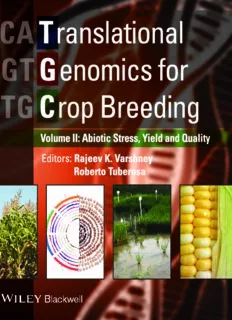
Translational Genomics for Crop Breeding: Volume 2 - Improvement for Abiotic Stress, Quality and Yield Improvement PDF
Preview Translational Genomics for Crop Breeding: Volume 2 - Improvement for Abiotic Stress, Quality and Yield Improvement
Translational Genomics for Crop Breeding, Volume II: Abiotic Stress, Yield and Quality Translational Genomics for Crop Breeding, Volume II: Abiotic Stress, Yield and Quality Edited by Rajeev K. Varshney Roberto Tuberosa Thiseditionfirstpublished2013(cid:2)C 2013byJohnWiley&Sons,Inc. Editorialoffices: 2121StateAvenue,Ames,Iowa50014-8300,USA TheAtrium,SouthernGate,Chichester,WestSussex,PO198SQ,UK 9600GarsingtonRoad,Oxford,OX42DQ,UK Fordetailsofourglobaleditorialoffices,forcustomerservicesandforinformationabouthowtoapplyforpermissionto reusethecopyrightmaterialinthisbookpleaseseeourwebsiteatwww.wiley.com/wiley-blackwell. Authorizationtophotocopyitemsforinternalorpersonaluse,ortheinternalorpersonaluseofspecificclients,isgranted byBlackwellPublishing,providedthatthebasefeeispaiddirectlytotheCopyrightClearanceCenter,222Rosewood Drive,Danvers,MA01923.ForthoseorganizationsthathavebeengrantedaphotocopylicensebyCCC,aseparate systemofpaymentshasbeenarranged.ThefeecodesforusersoftheTransactionalReportingServiceare ISBN-13:978-0-4709-6291-6/2013. Designationsusedbycompaniestodistinguishtheirproductsareoftenclaimedastrademarks.Allbrandnamesand productnamesusedinthisbookaretradenames,servicemarks,trademarksorregisteredtrademarksoftheirrespective owners.Thepublisherisnotassociatedwithanyproductorvendormentionedinthisbook. LimitofLiability/DisclaimerofWarranty:Whilethepublisherandauthor(s)haveusedtheirbesteffortsinpreparingthis book,theymakenorepresentationsorwarrantieswithrespecttotheaccuracyorcompletenessofthecontentsofthisbook andspecificallydisclaimanyimpliedwarrantiesofmerchantabilityorfitnessforaparticularpurpose.Itissoldonthe understandingthatthepublisherisnotengagedinrenderingprofessionalservicesandneitherthepublishernortheauthor shallbeliablefordamagesarisingherefrom.Ifprofessionaladviceorotherexpertassistanceisrequired,theservicesofa competentprofessionalshouldbesought. LibraryofCongressCataloging-in-PublicationData Translationalgenomicsforcropbreeding.VolumeII:abioticstress,yieldandquality/editedbyRajeevK.Varshneyand RobertoTuberosa. p.cm. Includesbibliographicalreferencesandindex. ISBN978-0-470-96291-6(cloth:alk.paper)–ISBN978-1-118-72837-6(epub)–ISBN978-1-118-72842-0(emobi)– ISBN978-1-118-72848-2(ebook)–ISBN978-1-118-72862-8(epdf) 1.Crops–Geneticengineering. 2.Plant breeding. 3.Plantgenomemapping. 4.Cropimprovement. I.Varshney,R.K.(RajeevK.),1973– II.Tuberosa,R. (Roberto) SB123.57.T742013 631.5(cid:3)3–dc23 2013029686 AcataloguerecordforthisbookisavailablefromtheBritishLibrary. Wileyalsopublishesitsbooksinavarietyofelectronicformats.Somecontentthatappearsinprintmaynotbeavailable inelectronicbooks. Coverimages:Background(cid:2)C HelenStocker;Cornfield(cid:2)C jess311;Cornonthecob(cid:2)C DianeDiederich CoverdesignbyMattKuhns Setin10/12.5ptTimesbyAptara(cid:2)R Inc.,NewDelhi,India 1 2013 Contents Foreword vii Preface ix Chapter1 TranslationalGenomicsforCropBreeding:AbioticStressTolerance,Yield, andQuality,AnIntroduction 1 RajeevK.VarshneyandRobertoTuberosa Chapter2 ApplyingGenomicsToolsforBreedingSubmergenceToleranceinRice 9 EndangM.Septiningsih,BertrandC.Y.Collard,SigridHeuer, JuliaBailey-Serres,AbdelbagiM.Ismail,andDavidJ.Mackill Chapter3 GenomicsApplicationstoSalinityToleranceBreedinginRice 31 J.DamienPlatten,MichaelJ.Thomson,andAbdelbagiM.Ismail Chapter4 Marker-AssistedIntrogressionofMajorQTLsforGrainYieldUnder DroughtinRice 47 ArvindKumar,ShalabhDixit,andAmeliaHenry Chapter5 MolecularBreedingforPhosphorus-efficientRice 65 SigridHeuer,J.H.Chin,R.Gamuyao,S.M.Haefele,andM.Wissuwa Chapter6 AluminumToleranceinSorghumandMaize 83 JurandirV.Magalhaes,LyzaG.Maron,MiguelA.Pin˜eros, ClaudiaT.Guimara˜es,andLeonV.Kochian Chapter7 FreezingToleranceintheTriticeae 99 GalibaGabor,EricJ.Stockinger,EnricoFrancia,JustynaMilc,GaborKocsy, andNicolaPecchioni Chapter8 MolecularBreedingforStay-Green:ProgressandChallengesinSorghum 125 VincentVadez,SantoshDeshpande,JanaKholova,PunnaRamu, andC.TomHash Chapter9 GeneticImprovementofGrainQualityinJaponicaRice 143 KiyosumiHoriandMasahiroYano Chapter10 BiofortifiedMaize–AGeneticAvenueforNutritionalSecurity 161 RamanBabu,NataliaPalacios,andBMPrasanna v vi CONTENTS Chapter11 Marker-AssistedBackcrossingSelectionforHighO/LRatioin CultivatedPeanut 177 PadmalathaKoilkonda,ChikaraKuwata,MasanobuFukami,KentaShirasawa, KohAoki,SatoshiTabata,MakotoHasegawa,HiroyukiKiyoshima, ShigeruSuzuki,ShigemiSasamoto,AtsushiKurabayashi,HisanoTsuruoka, TsuyukoWada,andSachikoIsobe Chapter12 Genomics-AssistedBreedingforTomatoFruitQualityintheNext-Generation OmicsAge 193 MatthewP.KinkadeandMajidR.Foolad Chapter13 ImprovementofYieldperseinSugarcane 211 M.Gouy,S.Nibouche,J.Y.Hoarau,andL.Costet AppendixI–Contributors 239 AppendixII–Reviewers 243 Index 245 Colorplatesectioncanbefoundbetweenpages82and83. Foreword ICRISAT’smissionistoreducepoverty,hunger, chickpea, pigeonpea, tomato, and so on is now malnutrition, and environmental degradation in availabletoenablegreaterunderstandingoftraits thedrylandtropics.Toaccomplishthis,weneed through comparative studies. It is important to to address the challenges presented by popu- further translate available genome information lation explosion and climate change and their in crop breeding so that farming communities impactsonagriculture. willbebenefittedsoonerthanlater. Today about 70% of the food-insecure pop- Translational Genomics for Crop Breeding: ulation lives in developing countries, mostly as Abiotic Stress, Yield and Quality, edited by Dr. small-scale and subsistence farmers, and their Rajeev K. Varshney, our own ICRISAT scien- populationgrowthisexpectedtotripleby2100. tist, and Professor Roberto Tuberosa from the Theyekeoutalivingandfeedthemselvesfrom UniversityofBologna,Italy,providesaconcrete food crops cultivated in degraded lands in an stepinthisdirection.Itisthesecondoftwovol- unequivocallywarmerclimatesystem. umes where the eminent editors have carefully To achieve global food security, the devel- selectedauthorswhoareexpertsintranslational opment of crop varieties that produce high genomicsincropbreedingfordifferenttraitsin yields in harsh climatic conditions will be a differentcropspeciestowritethevariouschap- key strategy. Although several desirable traits ters of this publication. These chapters provide have been developed in crop species through examples oftranslationalgenomics forenhanc- integratedbreedingpractices,self-sufficiencyin ingtolerancetoabioticstressesandqualitytraits foodgrainsandlegumespersehasremainedan inanumberofcrops.Ibelievethatsuchabookis elusivedreamforpoorpeopleinthedeveloping verytimely,informative,andofsuchqualitythat world. it will fill the gap that exists presently between The knowledge generated through advances genomescienceandcropbreeding. in genomics during the past two decades has Throughthispublication,wehopetheelusive enormous potential in advancing the quest for dream of poor people in the developing world abioticstress–tolerantcropsinthearidandsemi- willsoonerbecomeareality. aridregionsoftheworld.Moreover,DNA-based marker technologies have increased the preci- sioninmarker-assistedselection(MAS),thereby reducing the time for improving traits of inter- Hyderabad WilliamD.Dar est. Genome sequence information for impor- Date:June10,2013 DirectorGeneral, tant crops like rice, sorghum, maize, soybean, ICRISAT vii
Description: